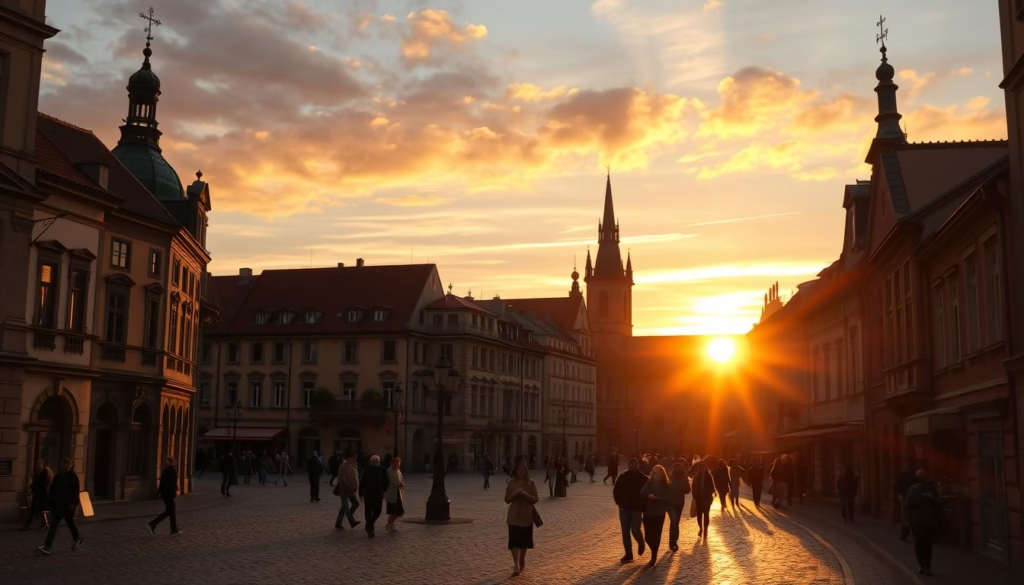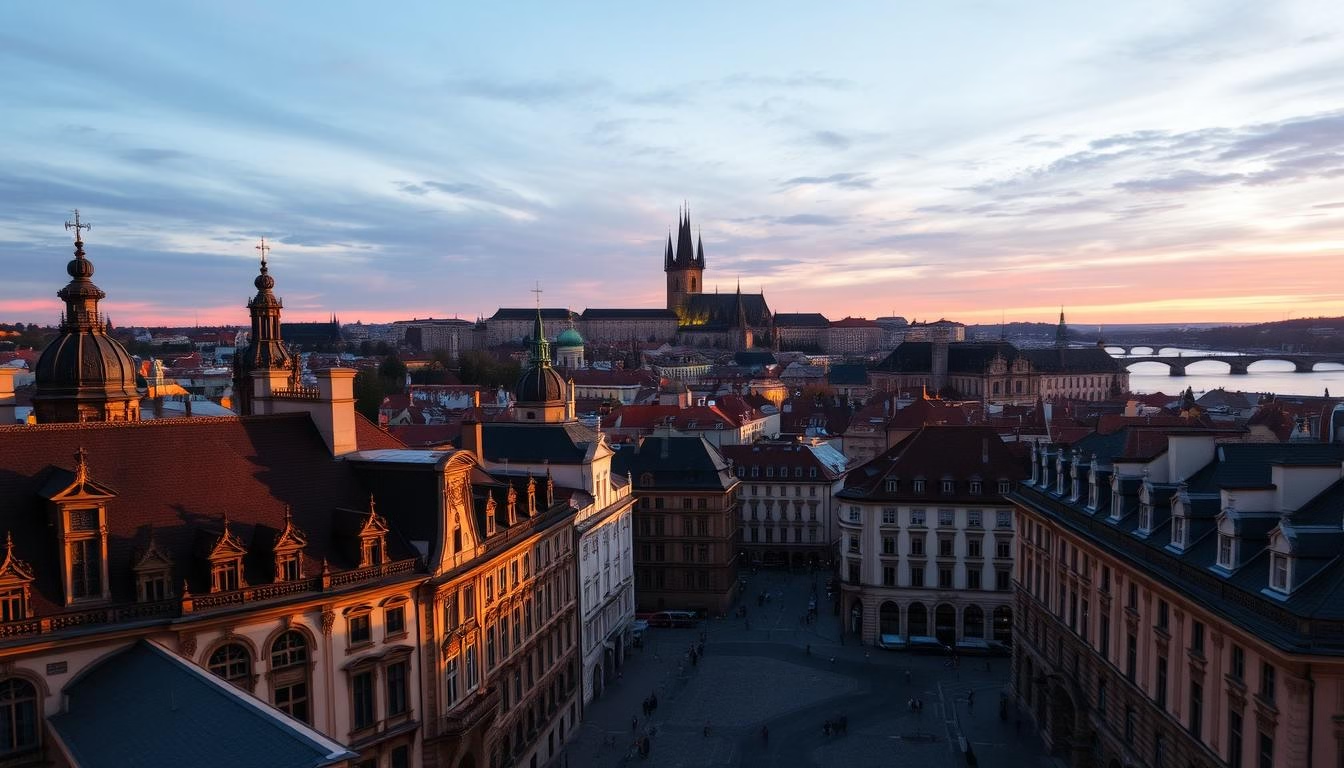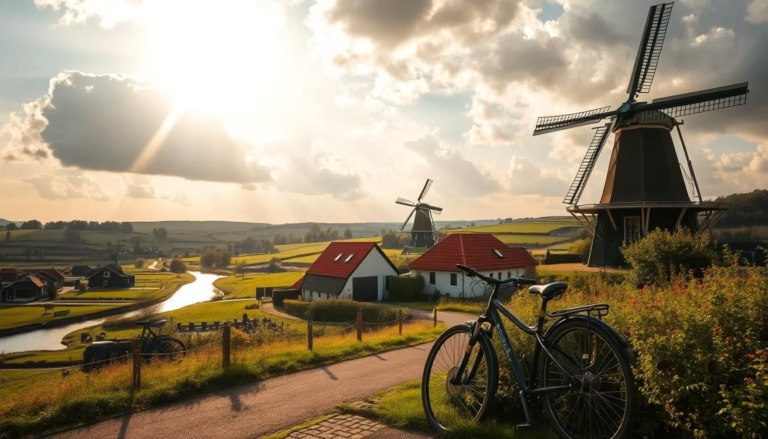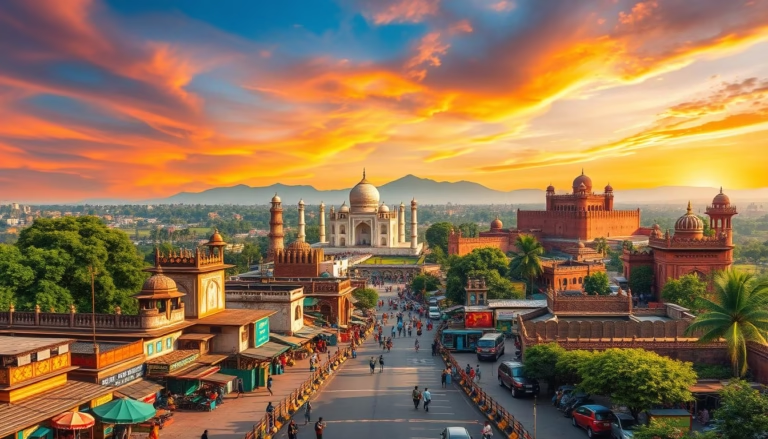Tourist Attractions in Prague: A Traveler’s Guide
Prague’s storybook skyline has captivated visitors for centuries. Known as the “City of a Hundred Spires,” this Central European gem blends medieval charm with vibrant modern energy. Once the seat of emperors and kings, its cobblestone streets now welcome travelers eager to explore architectural marvels that span nearly ten centuries.
Every season paints the capital in new colors. Winter brings cozy markets glowing under snow-dusted rooftops, while spring transforms parks into seas of pink cherry blossoms. Autumn wraps Letná Park in golden hues, creating a perfect backdrop for strolls along the Vltava River.
Beyond its beauty, Prague surprises with hidden courtyards and quirky cafés tucked between Gothic cathedrals and Baroque palaces. Whether you’re marveling at the Astronomical Clock or sipping craft beer in a renovated factory district, the city rewards curiosity at every turn.
Key Takeaways
- Ranked among Europe’s top destinations, outpacing cities like Amsterdam
- Offers year-round appeal with distinct seasonal highlights
- Features architectural styles from Gothic to Art Nouveau
- Combines iconic landmarks with lesser-known neighborhood treasures
- Boasts over 1,000 years of preserved history and culture
Introduction: Unveiling Prague’s Timeless Beauty
Every corner of Prague’s old town holds a piece of Europe’s storied heritage. Winding cobblestone lanes twist past Baroque facades and Gothic arches, their weathered stones whispering secrets from the 14th century. Hidden courtyards bloom with ivy-covered statues, while elegant arcades shelter cafes serving steaming trdelník pastries.

As daylight fades, the city dons its most enchanting guise. Gas lamps cast honeyed glows on Renaissance rooftops, and the Vltava River mirrors illuminated bridges. Locals say the “true magic begins when the clock towers throw shadows” – a daily transformation that turns history into living theater.
Centrally located in the Czech Republic, this urban masterpiece serves as a cultural crossroads. Its preservation of medieval layouts and Art Nouveau details creates a unique time capsule. Visitors often remark how seamlessly modern life unfolds beside structures older than the New World.
| Feature | Prague | Other European Cities |
|---|---|---|
| Original Medieval Layout | 95% intact | Avg. 40% preserved |
| Illuminated Monuments | 1,200+ | 500-800 typical |
| UNESCO Protected Area | 1.1 sq miles | 0.3-0.7 sq miles avg |
Photographers adore the old town’s ever-changing play of light and stone. Morning mist softens Prague Castle’s silhouette, while twilight accents the Astronomical Clock’s golden zodiac ring. Each season adds new drama – from winter’s frosted spires to autumn leaves framing Charles Bridge.
This Central European gem doesn’t just showcase history – it lets you walk through centuries in a single afternoon. From hidden convent gardens to panoramic hilltop views, the Czech Republic’s capital rewards those who wander without maps.
Discovering Tourist Attractions in Prague
Morning light reveals Prague’s most visited treasures. Three landmarks form the historic triangle drawing millions: Prague Castle’s hilltop majesty, Old Town Square’s medieval pulse, and Charles Bridge’s stone guardians. These icons shine brightest at dawn when golden light gilds ancient stones and early risers claim quiet moments.
Midday transforms these spaces into buzzing hubs. Locals recommend arriving before 8 AM or after 6 PM to experience their magic without shoulder-to-shoulder crowds. “The stones speak louder when you’re not shouting over tour groups,” advises a veteran guide.
Smart explorers balance must-see spots with nearby alternatives. Just beyond the square’s astronomical marvels lie Art Nouveau cafes and Gothic alleyways. Cross the Vltava via lesser bridges to find hilltop vineyards and modernist galleries.
| Landmark | Peak Crowds | Quiet Alternative |
|---|---|---|
| Prague Castle | 11 AM – 3 PM | Vyšehrad Fortress |
| Old Town Square | Noon – Sunset | Havelská Market |
| Charles Bridge | 9 AM – 7 PM | Manes Bridge Views |
The old town rewards those who wander beyond guidebook highlights. Cobbled lanes north of the square hide alchemists’ workshops turned into jazz clubs. Southward, floating restaurants bob beside 14th-century water towers.
Today’s travelers crave both iconic photos and authentic moments. Start with sunrise at the bridge, then lose yourself in the city’s labyrinthine side streets. This dual approach unlocks Prague’s full charm – grand spectacles and whispered secrets in equal measure.
The Majestic Prague Castle and St. Vitus Cathedral
Dominating Prague’s skyline for over a millennium, the castle complex began as a wooden fortress in the 9th century. Today, its sprawling 753,000 sq ft grounds hold three churches, seven gardens, and the Czech President’s office. This living timeline showcases Romanesque cellars beneath Baroque palaces, with Gothic spires reaching for the clouds.
Historical Significance and Architecture
Walk through eight centuries of power in one afternoon. The Prague Castle hosted Holy Roman Emperors and Habsburg rulers before becoming a presidential residence. “Each ruler left their mark like layers in a stone cake,” notes a local historian. St. Vitus Cathedral’s 600-year construction created a Gothic masterpiece where sunlight transforms Mucha’s stained glass into glowing jewels.
Essential Visitor Tips
Beat crowds by arriving at opening time (6 AM summer/7:30 AM winter). Sunset seekers should head to the Black Tower’s viewing platform – golden hour paints the St. Vitus spires in fiery hues. Save time with these smart strategies:
- Buy tickets online to skip ticket queues
- Focus on Cathedral + Old Palace (2.5 hour tour)
- Wednesdays see 30% fewer visitors than weekends
Don’t miss the 14th-century Golden Lane – its colorful cottages once housed castle guards and goldsmiths. With smart planning, you’ll experience royal grandeur without the rush.
Wandering Through the Old Town Square and Astronomical Clock
At the heart of the city lies a 600-year-old marvel where Gothic spires meet Baroque elegance. The Old Town Square has witnessed royal processions, medieval markets, and modern-day street performers since its days as a bustling 14th-century trading hub. Pastel buildings frame this UNESCO site like a life-sized storybook illustration.
Exploring Iconic Landmarks
All eyes tilt upward when the astronomical clock strikes. Built in 1410, this mechanical wonder comes alive as Death rings his bell and wooden apostles parade behind golden shutters. Locals joke that “even the skeleton keeps better time than Czech trains.”
The square’s skyline reveals three eras of architecture. Twin 260-foot spires crown the Gothic Church of Our Lady Before Týn, while Renaissance arcades shelter cafes serving honey cakes. Climb the Old Town Hall tower for views stretching from Charles Bridge to Prague Castle.
| Landmark | Best Time to Visit | Unique Feature |
|---|---|---|
| Astronomical Clock | 5 minutes before the hour | World’s oldest working clock mechanism |
| Church Spires | Morning light (7-9 AM) | 80-meter-tall Gothic peaks |
| Town Hall Tower | Weekday afternoons | Elevator to medieval viewing platform |
Insider Recommendations
Duck below street level to explore the old town’s hidden layers. Underground tours reveal 12th-century cellars where merchants stored goods and prisoners scratched messages into stone walls. Guides share that “these vaults held more secrets than the royal treasury.”
For quieter moments, visit the square at dawn or after dark. Early risers catch soft light on cobblestones, while night brings dramatic illuminations. Pair your exploration with trdelník pastries from bakeries lining nearby alleys.
Romance on Charles Bridge: Bridging History and Art
Dawn paints the Vltava River in soft gold as the first footsteps echo across Charles Bridge. Built in 1357 under King Charles IV, this 520-meter stone marvel connects Prague Castle to the Old Town through an avenue of 30 Baroque statues. Locals whisper that crossing it at sunrise ensures lifelong love.
By noon, the bridge transforms into a living gallery. Artists sketch portraits while saxophonists play “Moon River” under St. John of Nepomuk’s watchful gaze. His 1683 statue draws hopeful travelers – rubbing its bronze plaque supposedly brings fortune. “The bridge writes love stories with every sunset,” says a street painter who’s worked here 20 years.
| Time | Experience | Crowd Level |
|---|---|---|
| 5-7 AM | Mist-shrouded photography | Low |
| 10 AM-5 PM | Street performances | High |
| 8-10 PM | Moonlit strolls | Medium |
Three tips for savoring the magic:
- Walk barefoot on sun-warmed stones near the eastern railing
- Find the hidden cross marking the 1393 martyrdom site
- Listen for the faint chimes from Malá Strana’s church bells
As twilight deepens, the bridge‘s lanterns cast dancing shadows on centuries-old guard towers. This open-air museum proves some connections only grow stronger with time – especially those forged between travelers and timeless beauty.
Vibrant Vibes at Wenceslas Square and Beyond
Where medieval horse traders once bartered, fashion boutiques now display Bohemian crystal and artisanal leather goods. Wenceslas Square stretches like an urban runway, its 750-meter boulevard flanked by ornate Art Nouveau facades that glow amber at dusk. This living timeline has hosted independence celebrations in 1918 and the Velvet Revolution’s freedom chants in 1989.
| Historical Feature | Modern Equivalent | Visitor Tip |
|---|---|---|
| 14th-century market | Designer shopping arcades | Explore side streets for local brands |
| Protest sites | Open-air concerts | Check event schedules online |
| St. Wenceslas statue | National Museum steps | Climb for panoramic city views |
Winter transforms the square into a festive wonderland. From late November, wooden stalls sell cinnamon-spiced medovina under twinkling lights. “Our Christmas market feels like stepping into a snow globe,” shares a vendor arranging hand-painted ornaments.
Smart explorers combine culture with retail therapy:
- Morning: Coffee in Grand Hotel Europa’s art deco café
- Afternoon: Czech design shops along Na Příkopě Street
- Evening: Craft cocktails in a converted bank vault
Locals recommend visiting weekdays before noon when sunlight highlights architectural details on Neo-Renaissance buildings. Whether you’re tracing history or hunting for fashion treasures, this boulevard pulses with Prague’s modern heartbeat.
Exploring Hidden Gems: The Klementinum and Lesser-Known Libraries
Tucked behind unassuming walls near Charles Bridge lies a Baroque masterpiece few travelers expect. The Klementinum complex whispers secrets of Jesuit scholars through its gilded halls and celestial observatories. Once Europe’s third-largest Jesuit college, these buildings now guard treasures that make bibliophiles weak in the knees.
The Baroque Library Experience
Step into a room where knowledge wears golden robes. The library hall stuns visitors with ceiling frescoes depicting Enlightenment themes, their colors preserved since 1727. Sunlight filters through antique globes as you walk past shelves holding 20,000 volumes – some older than the United States Constitution.
Guides share fascinating details:
- Hidden staircase behind bookcases leads to rare manuscript collection
- Ceiling art shows zodiac symbols mixed with academic motifs
- Special climate system protects books since the 18th century
Celestial Views from the Astronomical Tower
Climb 172 steps to Prague’s original space observatory. The 68-meter astronomical tower once helped scientists track planetary movements. Today, visitors gasp at 360-degree views stretching from Old Town Square to Prague Castle’s spires.
Time your visit:
- Morning: Best photography light
- Afternoon: Guided tours explain historic instruments
- Dusk: Watch city lights awaken
Unique Architectural Details
Don’t rush past the Mirror Chapel – its name becomes clear when 4,700 glass pieces transform candlelight into starry skies. Nearby, the Strahov Monastery’s twin libraries showcase different eras. The Philosophical Hall’s ceiling painting spans 4,300 sq ft, while the Theological collection displays 17th-century globe maps.
Pro tip: Book combined tours early. These buildings limit daily visitors to protect their fragile beauty. As one librarian remarked, “We’re not hiding treasures – we’re preserving conversations across centuries.”
Natural Escapes: Letná Park and Petřín Hill
Above the city’s spires, green oases offer breathing room between sightseeing adventures. Letná Park sprawls across a plateau with postcard views of the Vltava’s curve. Once home to a 50-foot Stalin monument, the space now pulses to a different rhythm – a 75-foot metronome swings where political rallies once echoed.
The park’s beer garden serves cold brews under chestnut trees. Bring cash for crispy fried cheese and garlic-dipped pretzels. Locals joke that “the view improves with each sip” as sunlight dances on Prague Castle’s towers across the river.
Three reasons to visit:
- 360-degree city panoramas from Hanavský Pavilion
- Rollerblading paths winding through 50-acre green space
- Summer concerts at the metronome’s base
A mile south, Petřín Hill rises like a forested island. Hiking trails weave past rose gardens and mirror mazes to its crowning jewel – a 1891 observation tower. Clever engineers made its 58-meter frame match Paris’ Eiffel Tower when combined with the hill’s elevation.
Early mornings reveal hidden charms:
- Dew-kissed orchards near Strahov Monastery
- Quiet benches overlooking Malá Strana’s rooftops
- Stone staircases lined with wild poppies
Cultural Walks: Museums, Synagogues, and Modern Art
Beyond the well-trodden paths of spires and bridges lies a vibrant cultural tapestry. The city’s museums weave stories from medieval times to avant-garde movements, while synagogues in the Jewish Quarter stand as solemn reminders of resilience. Cutting-edge galleries along the Vltava’s banks showcase kinetic sculptures that seem to dance with the river’s current.
Immersive Museum of Senses
Step into a world where reality bends at every turn. This innovative space challenges perception through mirror labyrinths and rooms that defy gravity. “You’ll question whether your eyes or brain are playing tricks,” laughs a frequent visitor.
Book timed tickets online to enjoy the mind-bending exhibits without weekend crowds. Thursday evenings offer quieter exploration among optical illusions and tactile installations. Don’t miss the upside-down room – it’s a favorite for creative photo ops that’ll baffle friends back home.






